Note: Congrats to Barbara for recently adopting rescue pup, Wally! (previously known as Pablo)
I recently adopted a young rescue dog who was originally surrendered to a shelter by his first owner.
“Pablo” got lucky and was pulled from that shelter by a rescue organization here in my Central North Carolina neck of the woods, It Takes A Village Rescue, and went to live in a foster home.
From there, Pablo was adopted by a new family, but he ended up being returned after 2 months. The reason was “a sudden onset of dog allergies.” Whether or not this was the true reason remains debatable, but more importantly it meant that Pablo was homeless yet again.
It was around this time that I had contacted It Takes A Village in search of a new pup to bring home with me. After talking with one of the rescue ladies about what kind of dog I’d be interested in adopting, she asked if I’d be willing to foster Feist mix Pablo for a while, and I agreed.
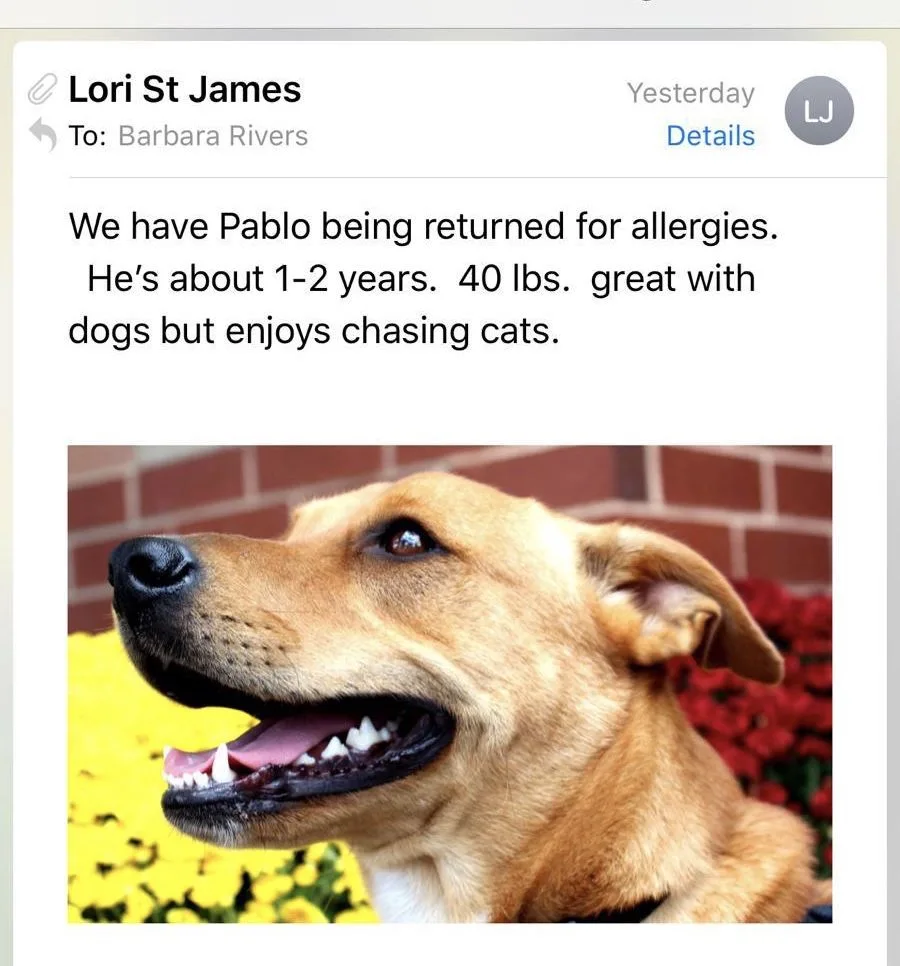
Long story short, I picked him up from her place just about 30 minutes after he had been returned there by his “suddenly allergic” first adopter.
Pablo stayed with me as my foster dog for 2 weeks before I decided to become a “foster failure” and adopt him myself! His new name is now Wally West, or Wally for short.
How to help your rescue dog adjust to his new home
Since my place is the 4th home Wally has been to in his relatively short life, I’m giving him plenty of time to adjust to his new surroundings while gently introducing him to a structured life with me. This new life consists of walking, training, experiencing new things, but also time to decompress.
1. Walking your new rescue dog
The very first thing we did together before even getting into my car and going home was to go for a 30 minute walk in the rescue lady’s neighborhood.
Wally loved stretching his legs and thoroughly enjoyed sniffing the grass, bushes, and countless mailboxes we walked by. I believe it was the right thing to do on my part and considered it sort of a polite way of introducing myself rather than just putting him into my car right away and driving off with him.
Once we were done walking, Wally hopped in as soon as the door to the backseat was open and gladly taste-tested the dehydrated beef heart treats I had brought along with me. His verdict was “yummy, more please!”
45 minutes later we arrived at my place and went for yet another 30 minute walk in my neighborhood before he put one single paw over my front door threshold. He sniffed around some more, peed and pooped, and seemed both intrigued yet fairly relaxed in this new area.
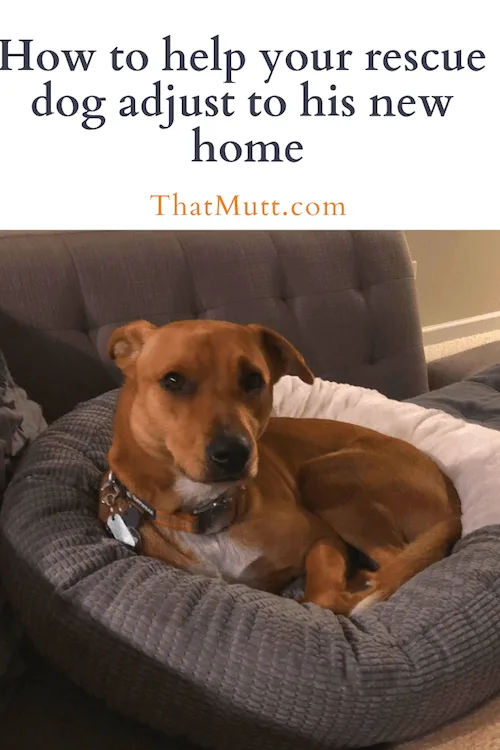
That’s exactly what I wanted to achieve with our walks. I wanted to drain him of some physical energy to make the transition into my place less stressful on him, keep him from finding an unsuitable outlet for his energy inside my house, and I also wanted to start working on establishing a bond between us.
The easiest way to bond with your dog is by doing activities together, and walking is certainly one that works for dogs.
Those two initial walks were followed by yard exploration, dinner, a chew treat, and snoozing on my couch.
Since then, we’ve made walking a daily habit and by now Wally knows exactly what to expect when I pull out his leash and backpack. He’s learned to sit by the front door, which still takes him a moment due to initial excited wigglebutt syndrome, and he knows that a little adventure awaits.
So to recap, regular walking has the following benefits:
- Gets rid of physical energy
- Lowers stress
- Limits problem behaviors
- Creates bond between handler and (rescue) dog
2. Training your rescue dog
Since I appreciate calm, well behaved dogs in general, and particularly inside my house, I made sure to teach Wally a few basic obedience commands right away. We began by incorporating the “sit,” followed by the “sit-stay,” both on walks and inside the house.
Teaching commands (and tricks) has the wonderful side effect of draining mental energy as the dog works on figuring out what his handler asks of him, so it’s a great way of tiring him out besides physical exercise. It’s also another activity you engage in together, resulting in strengthening the bond between you and your pup.
Since Wally loves edible goodies, I used his treat motivation when teaching him the new commands. At first I’d lure him into the “sit” position by holding a tasty treat slightly above his head, and it didn’t take long at all for him to catch on and plant his butt on the ground every time I pulled a treat out of my Mighty Paw treat pouch.
I then added the “stay” command to his sitting position by holding my palm right in front of his face while taking a small step backwards, adding the “stay” command, and then rewarding him when he stayed put. I can step back about 5 feet now with him holding the position. The distance between us will increase eventually as we continue practicing.
That being said, training sessions don’t have to last long at all. 5-10 minutes a few times per day will go a long way as long as they happen regularly. I ask(ed) Wally to “sit-stay” every single day:
- In the kitchen or on the patio before digging into his meals
- By the patio door before going out into the backyard
- By the front door before we leave the house to go for a walk as well as before going back inside
- On the couch or the living room floor while I hide treats in his snuffle mat
- Randomly during walks
I also started incorporating the “sit” command in the car before allowing him to hop out, and at check out time whenever we’ve gone to a pet retail store.
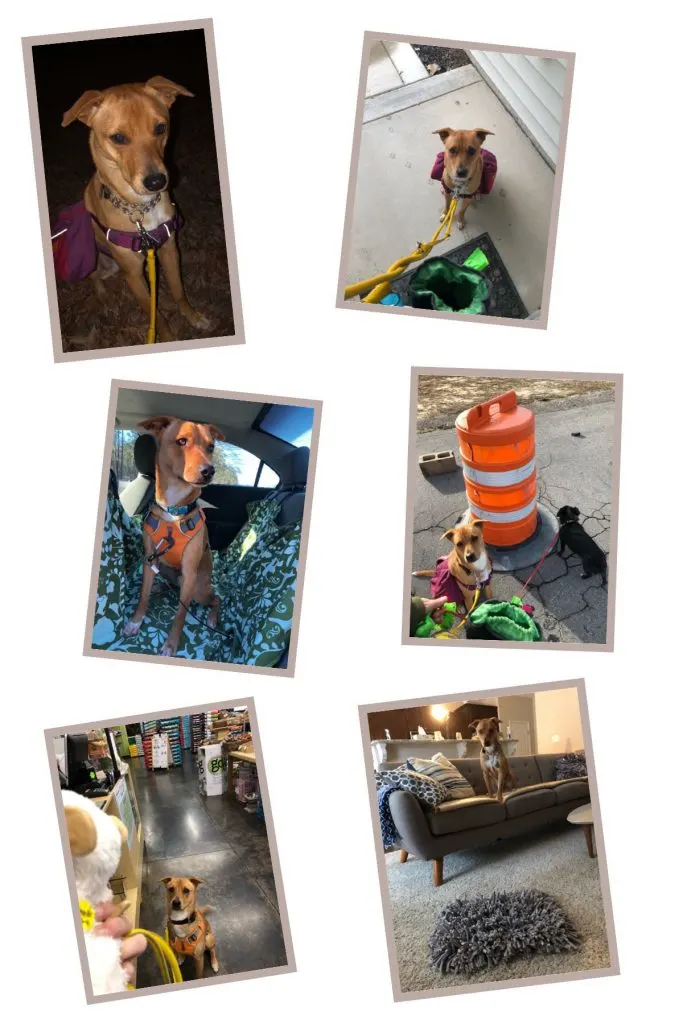
Another part of the transition into his new life was getting him used to his new name Wally.
I just didn’t see a Pablo in him, so I went ahed and applied the re-naming tip one of the rescue ladies gave me. When calling him, I’d simply add his new name Wally to his old name Pablo, so it sounded like “Hey Pablo Wally, come here, boy.” Then I’d slowly phase out Pablo and stick with just Wally. It took him about 2 weeks to get used to his new name.
As we’ll continue with our training schedule, we’ll slowly work on adding new commands and increasing the amount of distractions around him while he’s expected to obey. A group basic obedience class should be a good stepping stone for this endeavor, especially because seeing other dogs on walks still does distract him.
So to recap, regular training has the following benefits:
- Gets rid of mental energy
- Strengthens the bond between handler and (rescue) dog
- Turns dog into a polite pup, especially inside the house
- Adds structure to the dog’s daily routine
3. Introduce your rescue dog to new things
Another great way of draining Wally’s mental energy and strengthening our bond has been introducing him to new things, other dogs, and exploring new locations together.
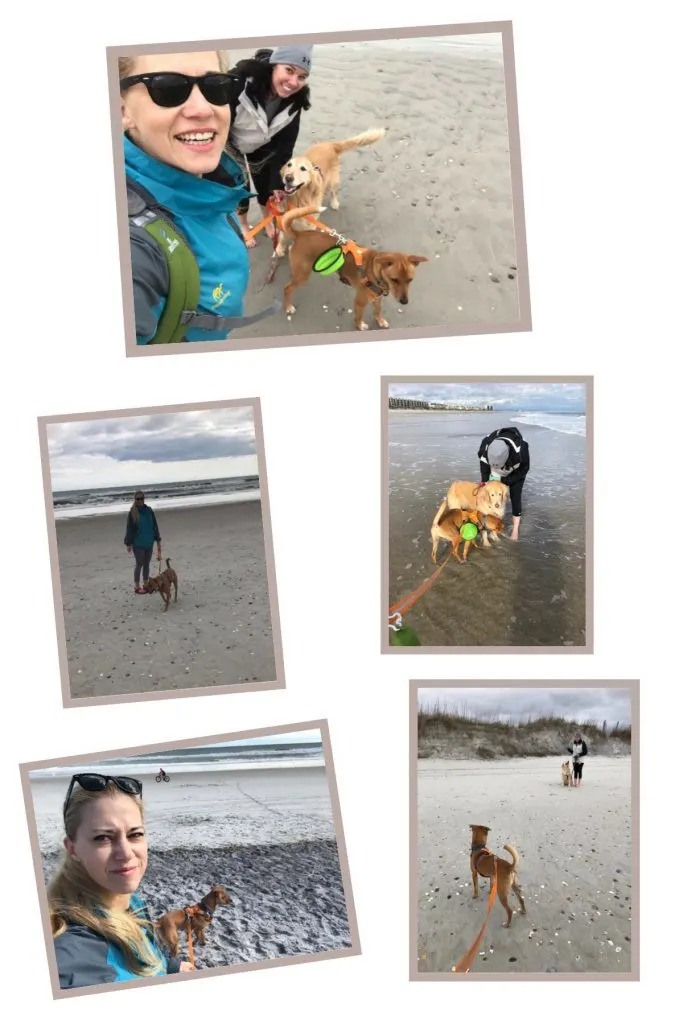
Over time it will also gradually make him more confident whenever he finds himself exposed to a new situation.
We’ve gone on countless car trips in the 5 weeks he’s been here with me, including our first day road trip to Wrightsville Beach on the NC coast, about 2 hours from us.
We went together with my friend Laura and her Golden Retriever Lucy and enjoyed all the new sights (all of us) and smells (the pups). Wally was also super interested in the seagulls prancing around us and would have loved chasing them, but I didn’t give him any off-leash time since he doesn’t have a reliable recall yet. Something to be worked on.
Other new locations I’ve taken Wally to besides the beach have been coffee shop drive-thrus (both Starbucks and small local ones), pet retail stores, local parks, his new vet, and the carwash.
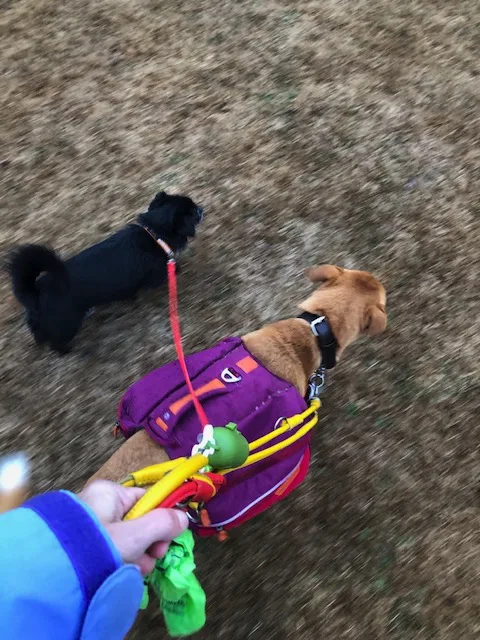
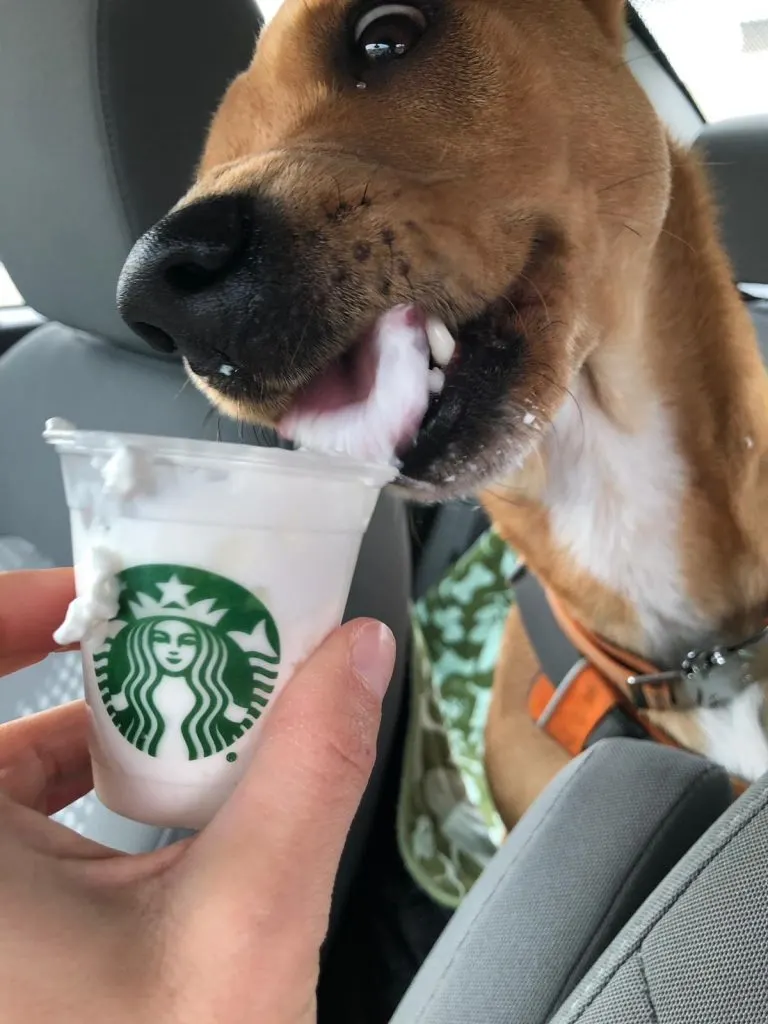
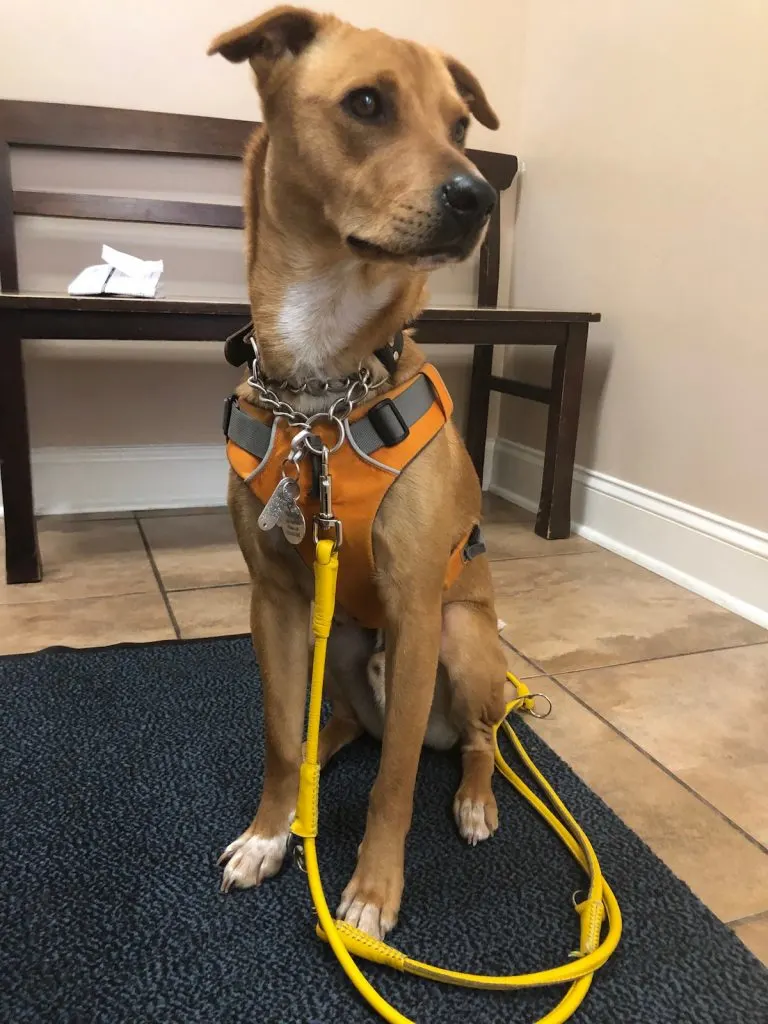
I want Wally to be social around dogs, so meeting other pups has been high on our to-do list as well. Besides meeting Golden Retriever Lucy, he’s gone on several walks with Pomeranian mix Lila and had playdates with Cocker Spaniel Houston.
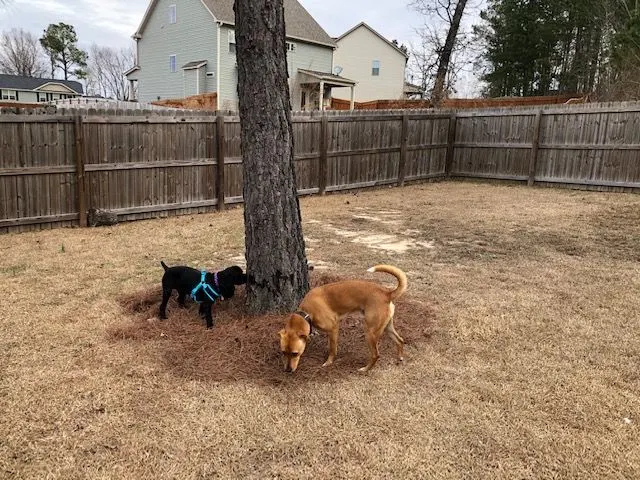
I’ve also introduced Wally to a number of new accessories around the house, including a doggie bed, a doggie backpack, a snuffle mat, a pet water fountain (review coming soon here on ThatMutt), a variety of leashes and collars, and new toys.
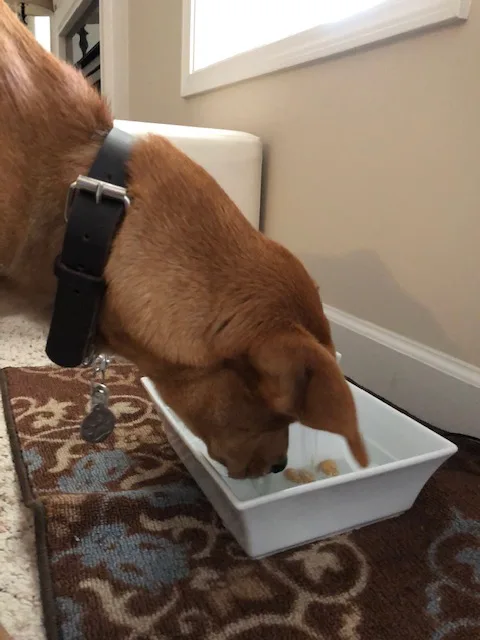
He was most puzzled by the doggie bed I got him and truly didn’t know what to do with it at first! He must never have had one before!
After two days of just sniffing it occasionally and eating the treats I tossed onto it but never lying down in it, I picked him up and placed him in the bed. I then gave him the “stay” command along with a treat and sat next to him.
That’s when he got the idea of what this comfy, soft thing was supposed to be – a lounging place just for him! Since then, he’s enjoyed his morning and afternoon naps curled up in the bed, and he’s also occasionally using it at night time 😉
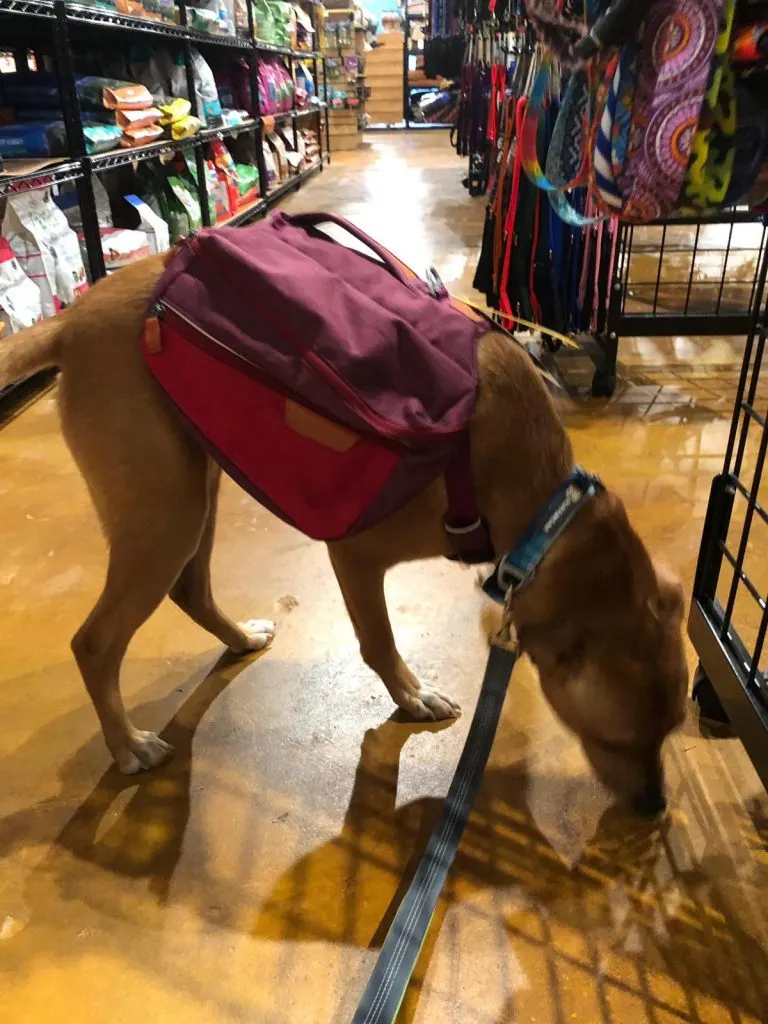
Getting Wally used to his new food was fairly uncomplicated. Those of you who have followed ThatMutt for a while know that I’m a raw feeder, so it was a no-brainer that Wally would start eating raw once he became my dog.
I had switched him from the poor Costco kibble he was on initially to a dehydrated food brand to help provide relief from his itchiness, and then made the switch to raw once I had adopted him. I first fed him ground, pre-made raw and then put my own meals together.
It took him about 2 days to get used to the different texture and at first, he’d repeatedly grab some larger cuts of meat and spit them back out into his bowl before eating them eventually, but now he’s finishing his raw meals in record time.
It’s important to remember to make the transition to a new food gradually, over the course of about 7-10 days, to avoid an upset stomach, and to be patient when transitioning to a diet different in texture.
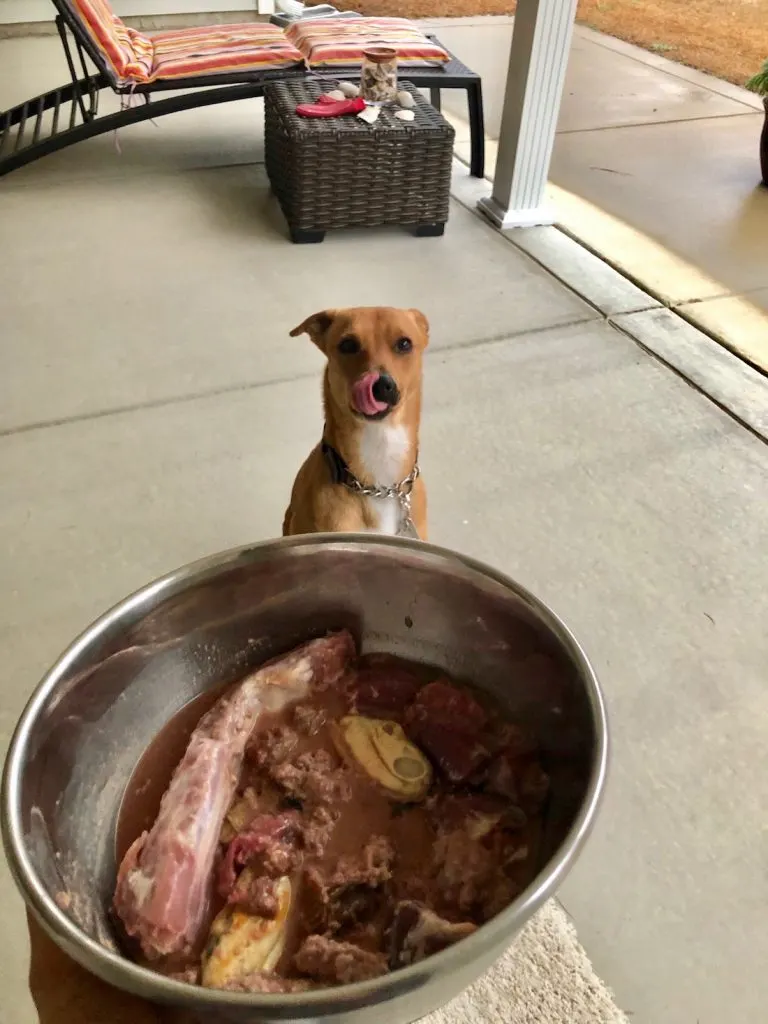
So to recap, introducing a (rescue) dog to new things such as the below listed drains mental energy and makes him more confident in new situations:
- New locations
- Play dates or walks with other dogs
- New chew toys & food
- New accessories like beds, leashes, collars, backpacks, bowls & feeders
4. Give your rescue dog time to decompress
All of these new impressions have kept Wally busy and contributed to tiring him out both physically and mentally, so he’s also been getting a decent amount of time to decompress every single day.
While he absolutely LOVES to snuggle with me (and my friends!) on the couch, he does have his very own doggie lounge area to retreat to in form of his doggie bed and his crate, along with bully sticks and a hollow bone filled with peanut butter for chewing entertainment.
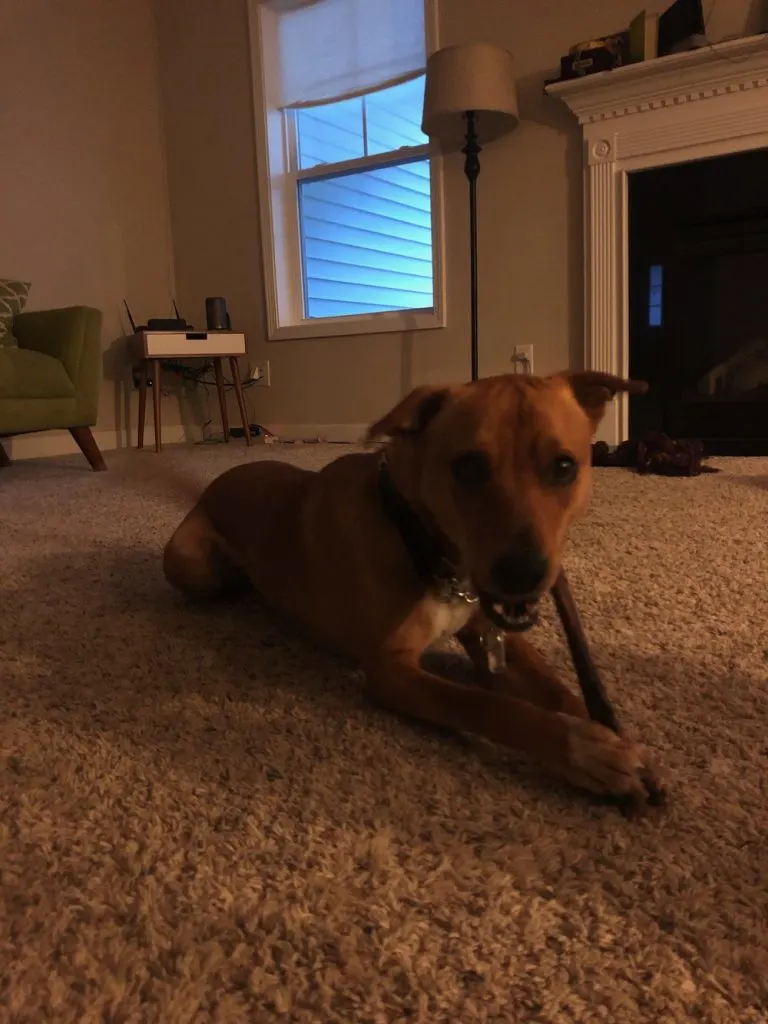
The latter came highly recommended to us by a Petco clerk when I asked about their toughest chew (toy), and it has worked great so far.
Wally usually naps in his doggie bed after breakfast, and has also been lounging in it while I’m gone during the day, usually between 9:30 am and 2:30 pm.
I crated him for the first 3 weeks when I wasn’t home, but he just recently graduated to having the reign of the downstairs when he’s alone. He’s been doing really well at just lounging, watching the backyard, and working on his chews without getting into anything inappropriate, so I’m really proud of how far he’s already come in those initial 5 weeks.
He’ll also spend a portion of the night in his bed, but will share a few hours next to me on a doggie blanket on my bed.
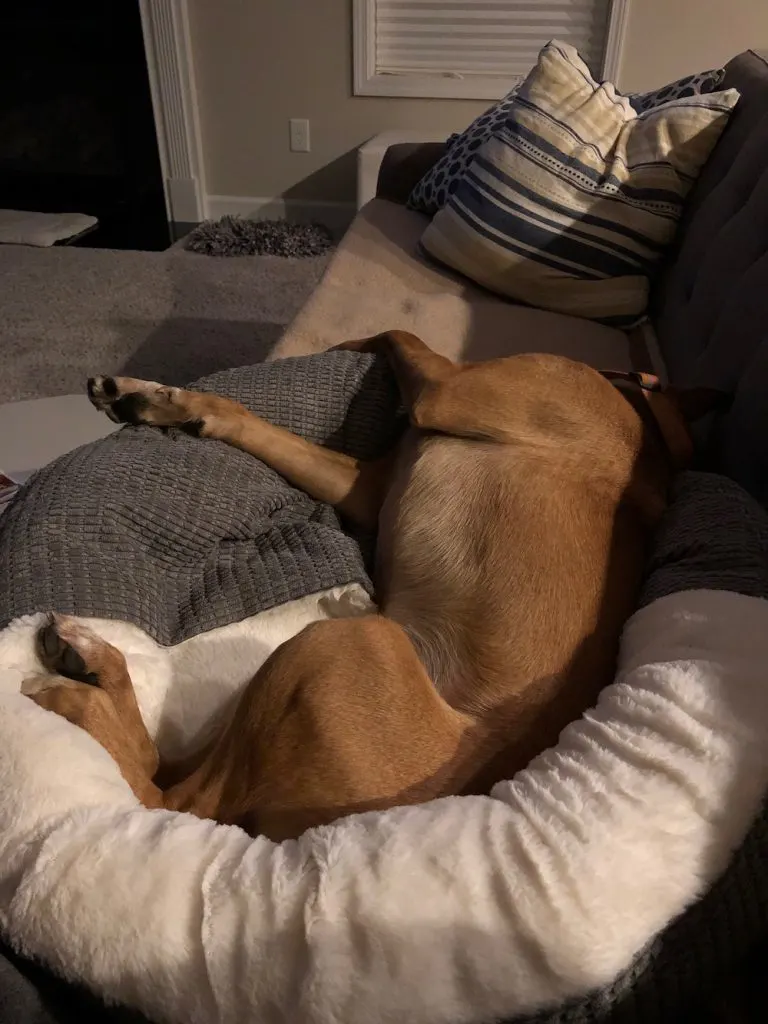
So to recap, a dog can decompress:
- In a safe area for him to retreat to, like a bed or a crate
- By chewing
- By snuggling with humans
How to help your rescue dog adapt to his new home – final thoughts
Wally and I have started working together as a team and made gradual progress on our quest of living a structured life together, and I’m proud of both of us for moving into the right direction.
It’s a fun and rewarding process overall, however it’s not always easy, especially when life happens and throws you a curveball.
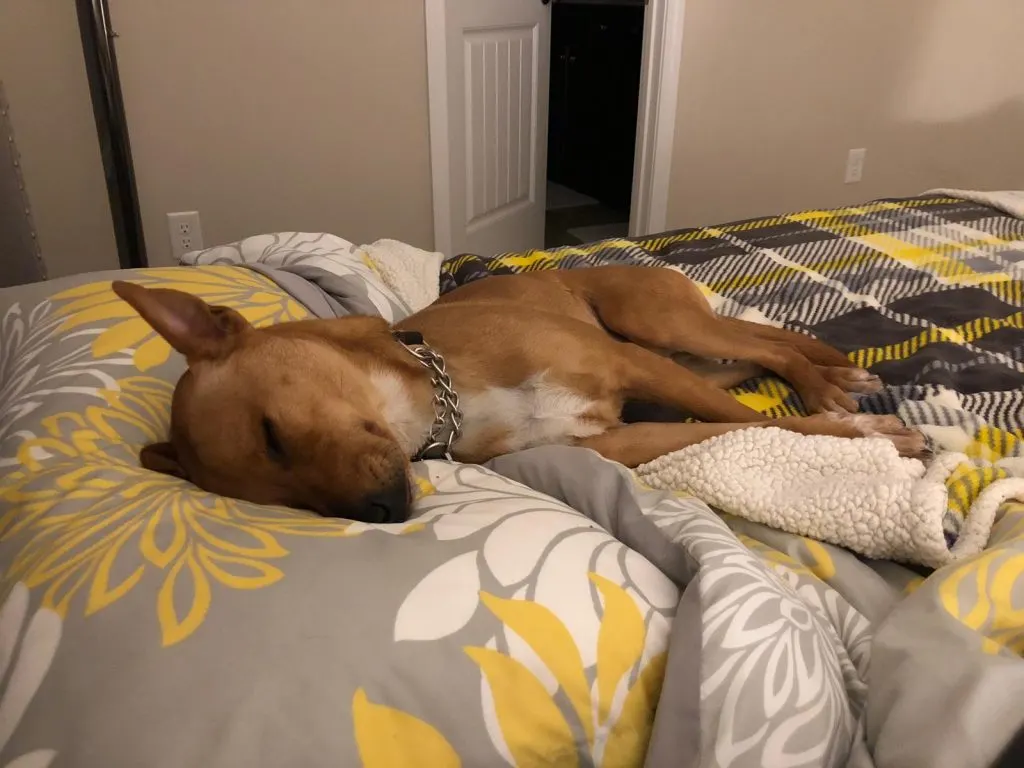
I was sick just last weekend and wasn’t able to take him on his walks on Sunday, so a friend stepped in and took Wally for two backpack walks that day. I was extremely thankful for the help because it meant that Wally was relaxed in-between his walks and able to calmly keep me company while I was resting. Having his chews readily available helped, too, in keeping him entertained.
For cases like these or similar life situations, I warmly suggest having a support system of family, friends, or a professional dog walker in place to help you out. Over the years, I’ve had countless dog walking clients myself who’ve booked me to walk their dogs when they were sick and not up to exercising or entertaining their pups themselves.
It’ll be challenging, but it’s in those moments that I’ll have to remember to be patient with myself and try to be as consistent as possible in setting Wally up for success in his new life.
Here’s to many, many years together with this pup – I can’t wait for all of our adventures!
Have you adopted a rescue dog?
Do you have any additional tips on how to introduce a rescue dog to their new life?
Barbara Rivers writes regularly for That Mutt. She is certified in raw dog food nutrition from Dogs Naturally Magazine and the author of three ebooks about balanced raw dog food. She is a blogger at K9s Over Coffee.

Diane Barnes
Wednesday 9th of December 2020
All of these tips are very useful — and timely for me, as I am currently looking to adopt a second dog. One thing I did not train my current dog to do, and will absolutely do this time around, is to go on walks without me, submitting to the discipline of a temporary master. My dog is so attached to me, she will refuse to go out with anyone else, although we sometimes have success having my daughter take her on short walks. But I know my dog is anxious to return home, even if I am not at home, and this kind of attachment is worrisome to me, so we’re working on it.
Thanks everyone for sharing your experience!
Diane B
Lindsay Stordahl
Wednesday 9th of December 2020
Oh yes, that is a good point. I've never had that issue but I can see why it would be good to prepare a dog to feel comfortable walking with others. Mine have always been eager to go with anyone! Too friendly!
David White
Wednesday 27th of February 2019
This is great information, more should seek out shelter dogs as the first resort for a new friend because they will also greatly benefit.
Julia T.
Tuesday 26th of February 2019
I think it's really important that you've thought things through so well. You're very conscious about his needs. You've also obviously considered what's important to you and how to help Wally adjust to your expectations. Good luck for the rest of the transition.
Barbara Rivers
Thursday 7th of March 2019
Thanks Julia!
Karen
Tuesday 26th of February 2019
Great article . Wally has the best! I'm working with Kodak slowly on the walking it's hard because he is stubborn, pulls hard on the leash and is reactive to other dogs and people. I take him to different spots where there's not likely to be many people. What is the backpack good for ?
jan
Tuesday 26th of February 2019
Good points, many people expect rescue dogs just to be grateful and know how to behave. They need help.
Barbara Rivers
Thursday 7th of March 2019
Thanks Jan. You're so right, and I have the feeling that Wally's first adopter didn't have the time and/or energy to work with him on basic obedience and helping him to settle in.
Serina J Rieckman
Tuesday 26th of February 2019
Great Advice! Only thing I would say is to fully switch to new name right away. You don't to "phase out" old commands or names before you teach new....it makes more confusing and takes longer for them to learn new stuff. The word sit is no different than word fido or hippo to a dog. They learn the definition by the result. My pup learned her name after 3 days because every time I said name she got treat lol. If you want to combine with something, can combine with command. "Fido Sit. Good sit Fido"
But otherwise love the article and recaps after each section! Good job!
Barbara Rivers
Thursday 7th of March 2019
Thanks Serina, that's a good point you made regarding teaching a new name. I'll definitely keep it in mind for the next dog whose name I'll want to change.